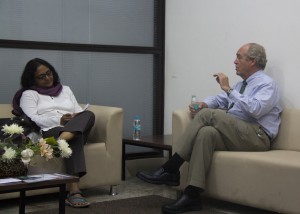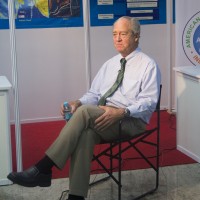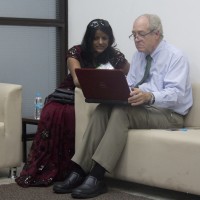Post 3 from the Indo-US Nuclear Safety Summit: The Consulate & Dr. Patrick Moore's speech
Margaret Harding is blogging from the ANS-sponsored Indo-US Nuclear Safety Summit in Mumbai, India.
On Thursday night there was an invitation-only dinner at the U.S. consulate offices in Mumbai. This is a new larger facility (at least that's what we were told) that reflects the USA's growing trade relationships with India. There is a traditional cake-cutting ceremony that recognizes the anniversary of the signing of the nuclear exchange agreement between our two countries.
Unfortunately, as I'm not an official photographer, I was not allowed to take my camera or my cell phone into the dinner, so I was unable to take any pictures or to tweet any activities. Donald Hoffman presented American Nuclear Society presidential citations to Dr. S. Banerjee and Dr. S.K. Jain for their efforts in expanding the civilian nuclear relationship between India and the United States. Commissioner Christine Svinicki, of the U.S. Nuclear Regulatory Commission, was in attendance at the dinner along with members of the U.S. diplomatic corps, and other key conference attendees.
The cake deserves a little discussion. It came from a very special bakery in Mumbai called "Tender Hands." This is a shelter for women who have been victimized in the sex trade in India and their children. Here, they are given safe shelter, taught life skills, and given work training to be able to start their own businesses. These women have baked the cake every year for this event. I congratulate the ANS India Section for supporting such a worthy cause.
Patrick Moore's Speech
I'm going to skip the Friday morning session for the moment and come back to it in a post on my own blog at www.4factorconsulting.com. That was a session that I helped to set up and participated in on communication, but I think Dr. Moore's speech is more important at the moment.
Dr. Moore talked about his life story a bit. How he ended up in the initial days of Greenpeace and why he left that movement. It's detailed in his book, "Confessions of a Greenpeace Dropout."
The short version is that he grew up on the northern end of Vancouver Island in a tiny village without roads. His love of the outdoors grew into a study of biology and the then-new science of ecology. Dr. Moore became involved with the early efforts by the group that would become Greenpeace in its efforts to stop nuclear weapons testing and in the subsequent "Save the Whales" campaign that became the foundation of the Greenpeace movement. Eventually he was one of the five international directors of the organization.
As time went on, he realized that the movement was making decisions not based on sound science but political and "sound bite" campaigns. He was the only scientist in a leadership position at the organization. Yet, the Greenpeace movement was moving into scientifically complex areas of environmental and ecologic impact. Dr. Moore's final break with the organization came when Greenpeace decided to campaign to end the use of chlorine worldwide. As a biologist and a scientist, he knew that the purification of drinking water around the world using chlorine has saved literally millions of lives and that such a campaign was directly harmful to the health and welfare of millions of people. This was an action he could not support-when Greenpeace continued with the effort, he left the organization
Dr. Moore went on to say "Greenpeace got many things right in those early days, but there were some things we got wrong. Three in particular: nuclear power, hydro electricity, and forestry." He then started talking about his current ecologic positions that are in stark contrast to the Greenpeace movement. The Green movement's anti-nuclear and anti-hydro stance has caused more pollution in the world, not less. Its failure to understand the larger eco-system tradeoff has done more damage to the environment that Greens claim to be trying to save.
The safety arguments that Greenpeace has used against nuclear power is also false. Statistically, working in the nuclear power industry is safer than either banking OR real estate when looking at workers. In addition, the fear of radiation is completely out of proportion to the impact. At Fukushima, Japan's independent radiation study group from Hiroshima has concluded that no one will die as a result of the Fukushima accident.
The other argument used by Greenpeace is nuclear waste. Dr. Moore went through an analysis of the material in a used fuel bundle and points out that with reprocessing and the use of fast reactors such as like India is researching, the long lived actinides are destroyed while creating even more energy. The remaining isotopes have much shorter half-lives and are gone within 300 years. This waste is also contained and easily protected from affecting the environment. When one looks at the amount of CO2 being dumped into the atmosphere with NO plan to eliminate it, the premise of Greenpeace becomes absurd.
Dr. Moore then looked at the larger energy picture. Most Greens are against hydro, nuclear, and fossil generation of electricity. He asked the question "but are they REALLY against coal?" Citing some statistics, he pointed out the Greens support and tout Denmark and Germany as shining examples of the use of renewables, yet both Denmark and Germany have higher CO2 emissions than Sweden, Switzerland, or France. Why? Because they rely on coal for the bulk of their electricity generation. Sweden, Switzerland, and France rely heavily on a mixture of hydro and nuclear and have achieved much lower CO2 emissions. If the Green parties were REALLY against coal and concerned about CO2, why do they support countries that use more coal? He stated emphatically that Greenpeace does not tell the truth about Germany, that the Germans are NOT going renewable energy and that they are building dozens of coal plants to make up for shutting down their nuclear plants.
 He also talked about the use of nuclear to turn coal into liquid fuels needed for transportation. This addresses concerns of peak oil and limits CO2 production to transportation where technology has not yet come up with viable alternatives to liquid fuel for many applications (trucking, container ships, etc.). He dismissed carbon capture and sequestration as a marketing ploy, not a real solution.
He also talked about the use of nuclear to turn coal into liquid fuels needed for transportation. This addresses concerns of peak oil and limits CO2 production to transportation where technology has not yet come up with viable alternatives to liquid fuel for many applications (trucking, container ships, etc.). He dismissed carbon capture and sequestration as a marketing ploy, not a real solution.
A Q-&-A session followed and then Dr. Moore did a number of interviews with reporters. I took the opportunity to get a few pictures of him. Unfortunately, Dr. Moore was not feeling well on this trip, so he isn't looking his best in these pictures. I hope to meet him again and get some better ones.
_________________________________________
Margaret Harding has almost 30 years of experience in the nuclear industry in technical design, licensing, and quality issues. She worked for GE-Hitachi for 27 years with positions of increasing responsibility, leading to vice president of Engineering Quality. Two years ago, she left GE-Hitachi to start her own consulting business to help companies with business ventures in the nuclear industry.




